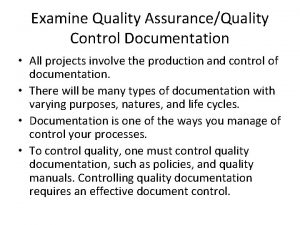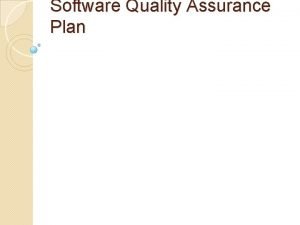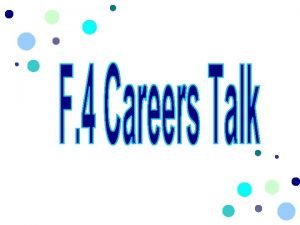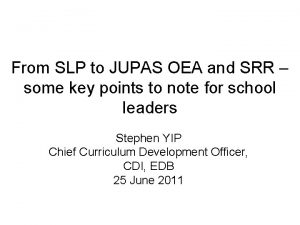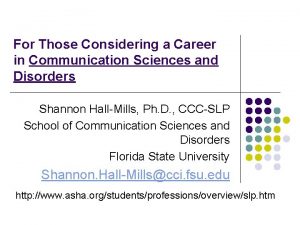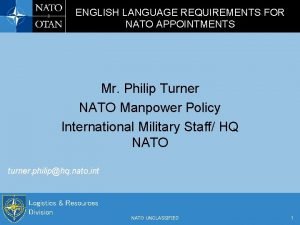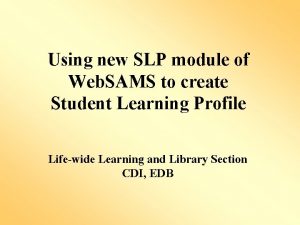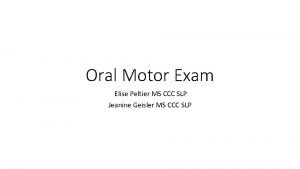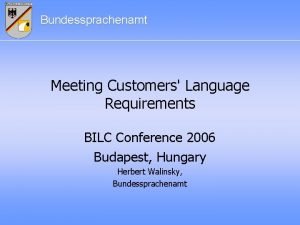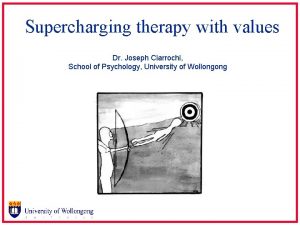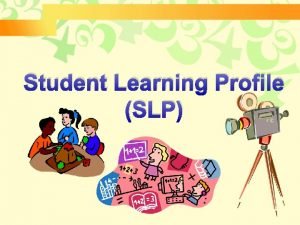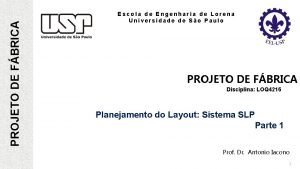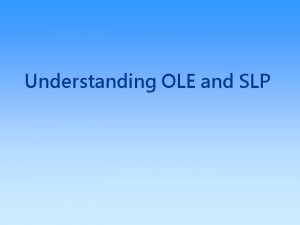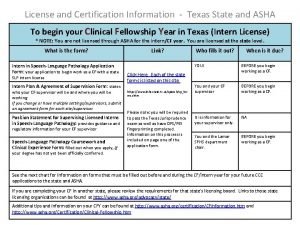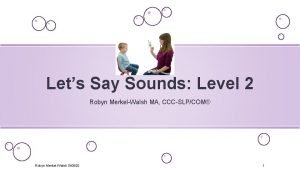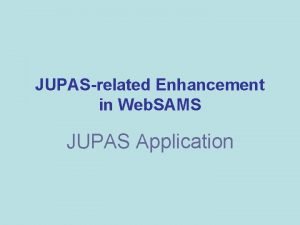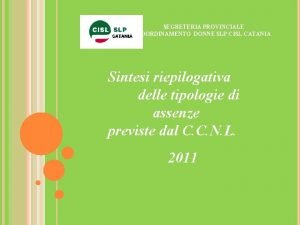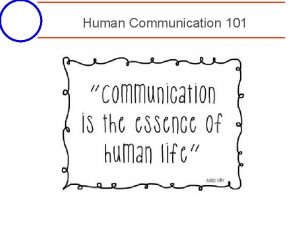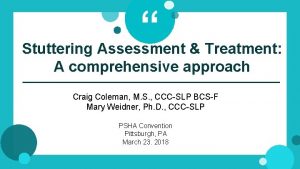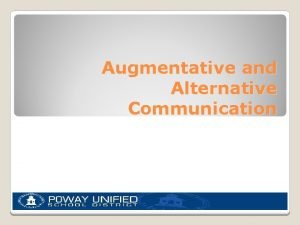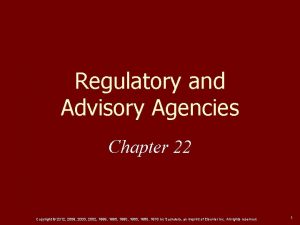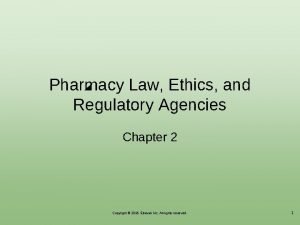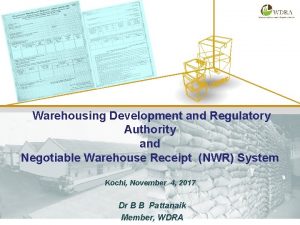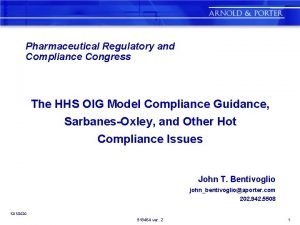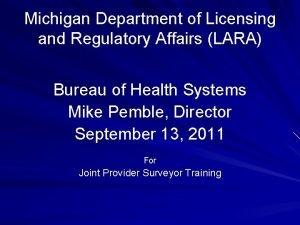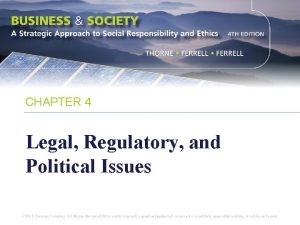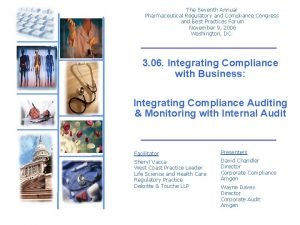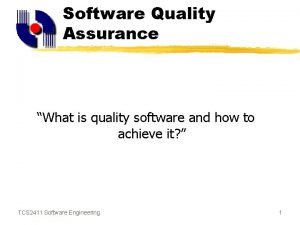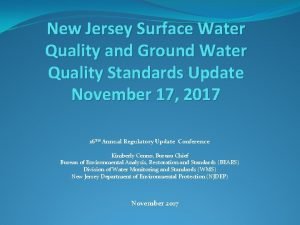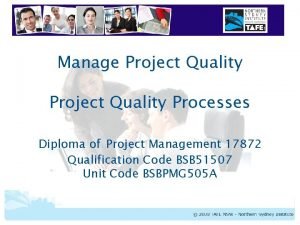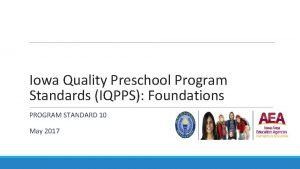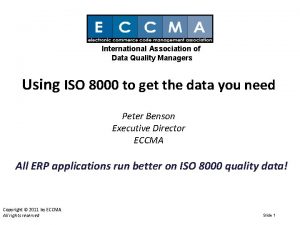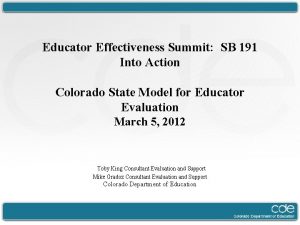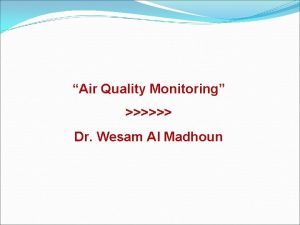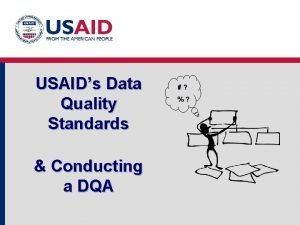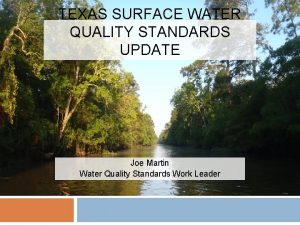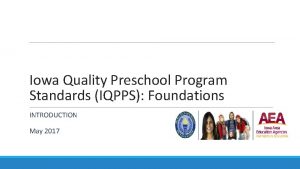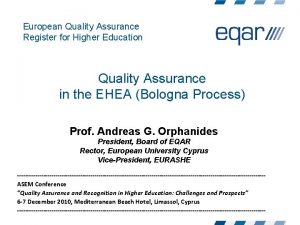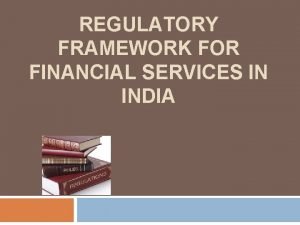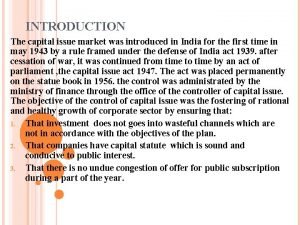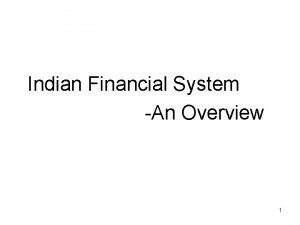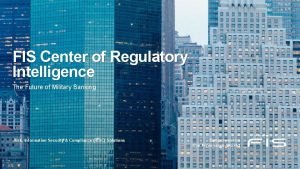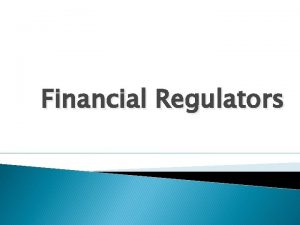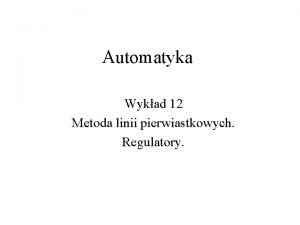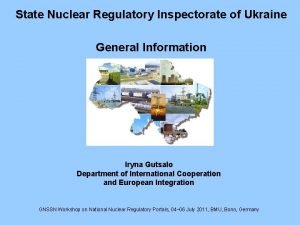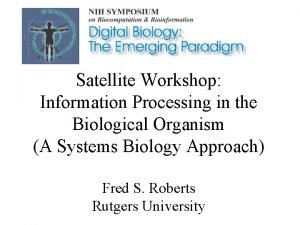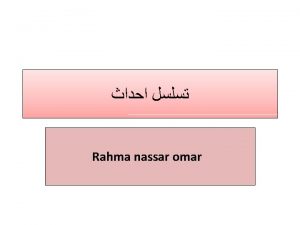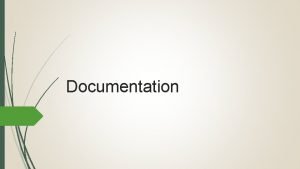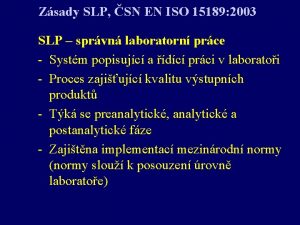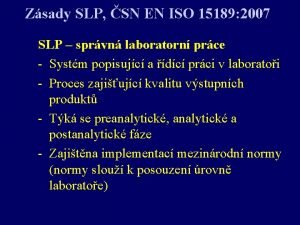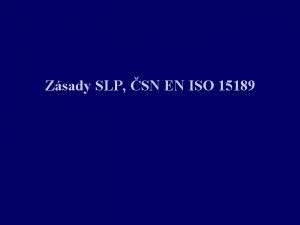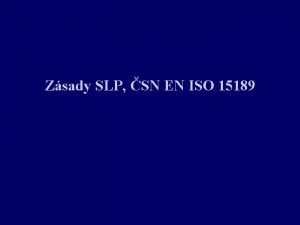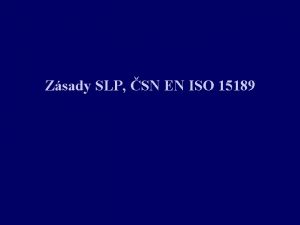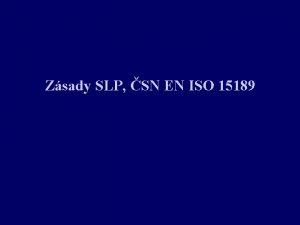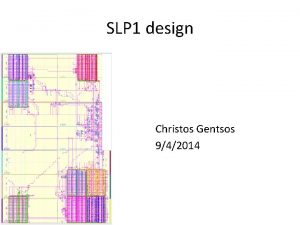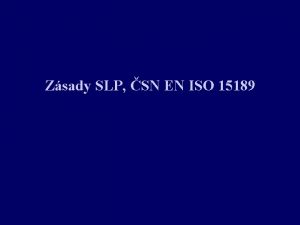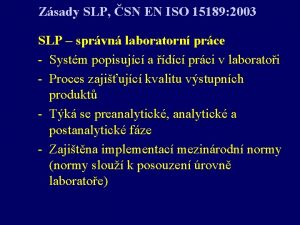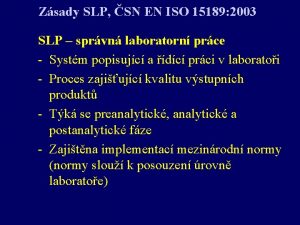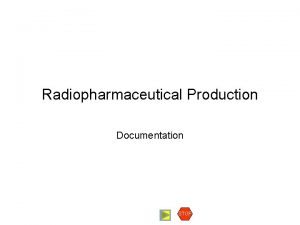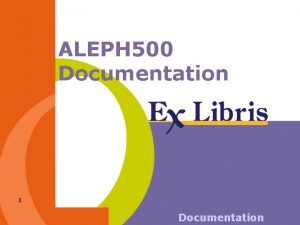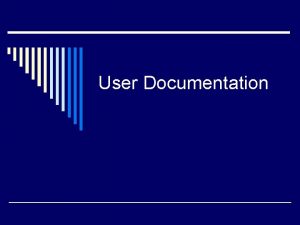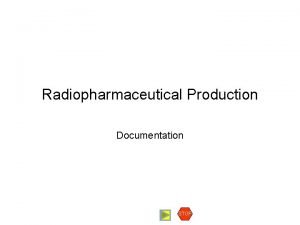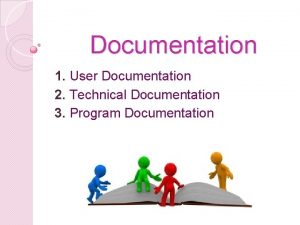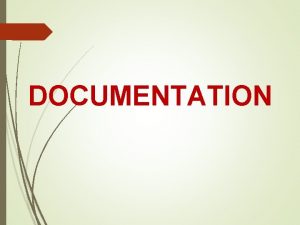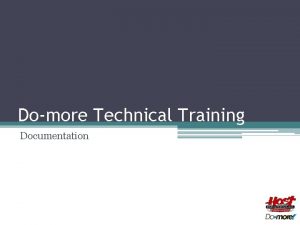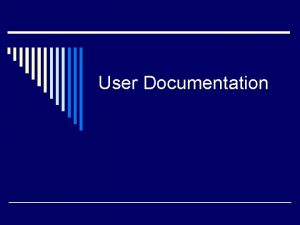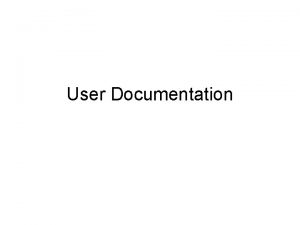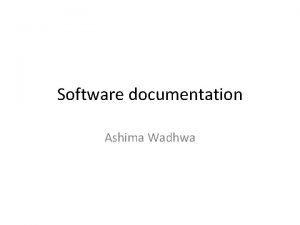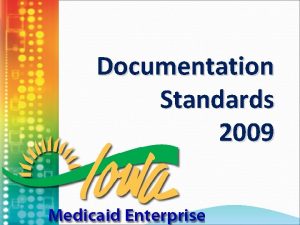SLP 1 QUALITY DOCUMENTATION AND REGULATORY STANDARDS WHAT



















































































- Slides: 83

SLP 1 QUALITY DOCUMENTATION AND REGULATORY STANDARDS: WHAT YOU NEED TO KNOW Renee Kinder, MS, CCC-SLP, RAC-CT, Director of Clinical Education for Encore Rehabilitation KSHA 2017 1

Course Description ◦ Documenting your unique level of skilled care as an SLP can be a challenging process. This course will outline what the regulatory standards are for documenting SLP services in addition to providing real world case studies to encourage practical application of learned material(Intermediate) KSHA 2017 2

Course Objectives ◦ The learner will be able to: ◦ 1) explain Medicare regulations which guide “skilled care”; ◦ 2) demonstrate ability to document care which is evidence-based and complex and sophisticated in nature; and ◦ 3) describe requirements for completion of and documentation for a hands-on assessment, progress report and daily note ◦ This session is pre-recorded. Attendees will view the video recorded session. The session moderator will accept questions for the speaker at the end of the session and attendees will receive the speaker’s responses after the conference KSHA 2017 3

Know your REGULATIONS ◦ Medicare Benefit Policy Manual Chapter 15 Section 220 ◦ National Coverage Determinations ◦ Local Coverage Determinations ◦ Regional Specific KSHA 2017 4

MEDICARE BENEFIT POLICY MANUAL CHAPTER 15 “REASONABLE AND NECESSARY” KSHA 2017 5

Indications for Speech Therapy Services ◦ Speech-language pathology services are those services provided within the scope of practice of speech-language pathologists ◦ Necessary for the diagnosis and treatment of speech and language disorders, which result in communication disabilities and for the diagnosis and treatment of swallowing disorders (dysphagia) ◦ Regardless of the presence of a communication disability. (See CMS Publication 100 -03, Medicare National Coverage Determinations (NCD) Manual, Part 3, Section 170. 3) (CMS Publication 100 -02, Medicare Benefit Policy Manual, Chapter 15, Section 230. 3(A)) KSHA 2017 6

“Reasonable and Necessary” Evidenced Based Practice ◦ The services shall be considered under accepted standards of medical practice to be a specific and effective treatment for the patient's condition. Acceptable practices for therapy services are found in: ◦ Medicare manuals (such as this manual and Publications 100 -03 and 100 -04), ◦ Contractors Local Coverage Determinations (LCDs and NCDs are available on the Medicare Coverage Database: http: //www. cms. hhs. gov/mcd and ◦ Guidelines and literature of the professions of physical therapy, occupational therapy and speech-language pathology. To be considered reasonable and necessary, the following conditions must be met: (CMS Publication 100 -02, Medicare Benefit Policy Manual, Chapter 15, Section 220. 2(B)) KSHA 2017 7

“Reasonable and Necessary” Complexity and Sophistication ◦ The services shall be of such a level of complexity and sophistication or the condition of the patient shall be such that the services required can be safely and effectively performed only by a qualified therapist ◦ Services that do not require the performance or supervision of a therapist are not skilled and are not considered reasonable or necessary therapy services, even if they are performed or supervised by a qualified professional. ◦ If the contractor determines the services furnished were of a type that could have been safely and effectively performed only by or under the supervision of such a qualified professional, it shall presume that such services were properly supervised when required. However, this presumption is rebuttable, and, if in the course of processing claims it finds that services are not being furnished under proper supervision, it shall deny the claim and bring this matter to the attention of the Division of Survey and Certification of the Regional Office. To be considered reasonable and necessary, the following conditions must be met: (CMS Publication 100 -02, Medicare Benefit Policy Manual, Chapter 15, Section 220. 2(B)) KSHA 2017 8

“Reasonable and Necessary” Medical Diagnoses ◦ While a beneficiary's particular medical condition is a valid factor in deciding if skilled therapy services are needed, a beneficiary's diagnosis or prognosis should never be the sole factor in deciding that a service is or is not skilled. The key issue is whether the skills of a qualified therapist are needed to treat the illness or injury, or whether the services can be carried out by nonskilled personnel. See item C for descriptions of skilled (rehabilitative) services. To be considered reasonable and necessary, the following conditions must be met: (CMS Publication 100 -02, Medicare Benefit Policy Manual, Chapter 15, Section 220. 2(B)) KSHA 2017 9

“Reasonable and Necessary” Determining Appropriate Frequency and Duration ◦ There must be an expectation that the patient's condition will improve significantly in a reasonable (and generally predictable) period of time, or the services must be necessary for the establishment of a safe and effective maintenance program required in connection with a specific disease state. In the case of a progressive degenerative disease, service may be intermittently necessary to determine the need for assistive equipment and/or establish a program to maximize function (see item D for descriptions of maintenance services); and ◦ The amount, frequency, and duration of the services must be reasonable under accepted standards of practice. The contractor shall consult local professionals or the state or national therapy associations in the development of any utilization guidelines. KSHA 2017 10

CODING: YOUR FIRST DEFENSE KSHA 2017 11

Coding- Keeping Control YOUR ST CLAIM PAYER BOM EMR KSHA 2017 12

Documentation: Evaluation CPT Codes KSHA 2017 13

92610: Evaluation of Oral & Pharyngeal Swallowing Function Medicare Benefit Policy Manual (MBPM), Dysphagia Defined: Dysphagia, or difficulty in swallowing, can cause food to enter the airway, resulting in coughing, choking, pulmonary problems, aspiration or inadequate nutrition and hydration with resultant weight loss, failure to thrive, pneumonia and death. It is most often due to complex neurological and/or structural impairments including head and neck trauma, cerebrovascular accident, neuromuscular degenerative diseases, head and neck cancer, dementias, and encephalopathies. For these reasons, it is important that only qualified professionals with specific training and experience in this disorder provide evaluation and treatment (1). MBPM, Swallowing Assessment Inclusions: Swallowing assessment and rehabilitation are highly specialized services. The professional rendering care must have education, experience and demonstrated competencies. Competencies include but are not limited to: ◦ Identifying abnormal upper aerodigestive tract structure and function ◦ Conducting an oral, pharyngeal, laryngeal and respiratory function examination as it relates to the functional assessment of swallowing ◦ Recommending methods of oral intake and risk precautions ◦ Developing a treatment plan employing appropriate compensations and therapy techniques (2). KSHA 2017 14

2014 Evaluation Codes Defined v 92521 Evaluation of speech fluency (e. g. , stuttering, cluttering) v 92522 Evaluation of speech sound production (e. g. , articulation, phonological process, apraxia, dysarthria) v 92523 Evaluation of speech sound production (e. g. , articulation, phonological process, apraxia, dysarthria); with evaluation of language comprehension and expression (e. g. , receptive and expressive language) v 92524 Behavioral and qualitative analysis of voice and resonance KSHA 2017 15

Can new codes be billed together same day? v. The CPT Handbook does not include language to restrict an SLP's ability to bill these codes together because there are circumstances when it is appropriate for a patient to be evaluated for multiple disorders on the same day. v. Note- In those cases, documentation should clearly reflect a complete and distinct evaluation for each disorder. KSHA 2017 16

One Hour Time Based Eval Codes v 92626 - Evaluation of Auditory Rehabilitation Status; First Hour ◦ 92627 Evaluation of Auditory Rehabilitation Status; Each addition 15 minutes v 96125 - Standardized cognitive performance testing (e. g. , Ross Information Processing Assessment) per hour of a qualified health care professional's time, both face-to-face time administering tests to the patient and time interpreting these test results and preparing the report. Per Hour. v 96105 - Assessment of Aphasia (includes assessment of expressive and receptive speech and language function, language comprehension, speech production ability, reading, spelling and/or writing ex. by BDAE) with interpretation and report- Per Hour v 92607 Evaluation for prescription for speech-generating AAC device face to face with the patient- First Hour. • 92608 Evaluation for prescription for speech-generating AAC device face to face with the patient- Each additional 30 minutes. KSHA 2017 17

Is my documentation time included? ◦ Medicare Part A ◦ MDS Section O: Rules for Recording Treatment Minutes ◦ (RAI Manual, Chapter 3, Section O; directly-quoted text is in italics) ◦ The therapist's time spent on documentation or on initial evaluation is not included (Page O 17) ◦ The therapist's time spent on subsequent reevaluations, conducted as part of the treatment process, should be counted (Page O 17) http: //www. asha. org/Practice/reimbursement/medicare/Medicare-Guidance-for-SLP-Services-in. Skilled-Nursing-Facilities/ ◦ Medicare Part B ◦ 96105 and 96125 billing for Medicare Part B beneficiaries follows the definition of codes set forth per LCD definitions therefore allowing ST to account for interpretation time in assessment. KSHA 2017 18

Case Studies Mr. Smith is admitted to SNF following acute onset of RCVA requiring standardized measure of language and cognitive functions v 96105 - Assessment of Aphasia AND/OR v 96125 - Standardized Cognitive Performance Testing ** Think about clinical appropriateness when selecting evaluation type** Will I mentally fatigue if I assess all areas day one? v. After 6 weeks of intensive treatment you determine he will require speech generating AAC device to meet communicative needs. Use 92607 - Evaluation for prescription for speech generating AAC Device KSHA 2017 19

Case Studies Mr. Smith is referred for evaluation due to stuttering. He presents with Advanced Dementia. v. Remember- Dysfluency services are not typically covered by Medicare, nor would interventions aimed at fluency be supported by Evidenced Based Practice Patterns. v. Use 92523 Eval of Speech Sound Production with Eval of Language Comprehension and Expression AND/OR v 96105 - Assessment of Aphasia if patterns follow diagnostic criteria for Primary Progressive Aphasia associated with Dementia OR v 96125 - Standardized Cognitive Performance Testing inclusive of Dementia Staging Tools when disease process follows AD type Dementia. KSHA 2017 20

DOCUMENTING: PLAN OF CARE REQUIREMENTS KSHA 2017 21

Evaluation Defined An EVALUATION is a separately payable comprehensive service provided by a clinician, as defined above, that requires professional skills to make clinical judgments about conditions for which services are indicated based on objective measurements and subjective evaluations of patient performance and functional abilities (BASELINES). An Evaluation is warranted e. g. , for a new diagnosis (change from plof). These evaluative judgments are essential to development of the plan of care, including goals and the selection of interventions. KSHA 2017 22

Documentation Overview: Plan of Care (POC) Requirements ü Order or Referral ü Clear distinction for Evaluation/Re-evaluation or Screening ü Beneficiary's History and the Onset or Exacerbation Date of the current disorder. ü History in conjunction current symptoms must establish support for additional treatment. ü Prior Level of Functioning should be documented ü Baseline abilities should be documented ü PLOF + Baseline establish the basis for therapeutic interventions. ü Plan, Goals (realistic, long-term, functional goals) ü Duration of therapy, Frequency of therapy, and definition of the Type of Service. ü Diagnostic and assessment testing services to ascertain the type, causal factor(s) should be identified during the evaluation. ü Clarify if plan is anticipated to be rehabilitative/restorative or maintenance based KSHA 2017 23

STEPS Step 1: Order Received Step 2: Screen Step 3: Evaluate and Determine if Skilled Intervention is Necessary Step 4: Establish POC Step 5: Write Clarification Order Step 6: Get POC Certified Step 7: Re Eval as appropriate Step 8: Recertify when necessary KSHA 2017 24

STEP 1: Order/Referral ◦ Needed for initial evaluation ◦ MD signature on POC acts as certification/clarification of services after evaluation ◦ New signature/certification needed for: ◦ Any significant updates to POC affecting LTG (will require re-eval or recertification) ◦ Addition of new interventions not included on initial plan. ◦ Example-ST begins services for dysphagia alone, as resident progresses with laryngeal function further eval is warranted for voice and motor speech ◦ PT completes initial POC for wound care and progresses patient to point where standard PT eval is reasonable and necessary ◦ Recertification of POC KSHA 2017 25

STEP 2: “Screening” ◦ Screening assessments are non-covered and should not be billed. ◦ The initial screening assessments of patients or regular routine reassessments of patients are not covered. Think…. . Screening Tells you Eval or Not Eval No Clinical Judgments or Skilled Recommendations Should be Made from Screen Alone KSHA 2017 26

STEP 3: Evaluation ◦ The order or referral for the evaluation and any specific testing in areas of concern should be designated by the referring physician in consultation with therapist. ◦ The documentation of the evaluation or re-evaluation by therapist should demonstrate that an actual hands-on assessment occurred to support the medical necessity for reimbursement of the evaluation or re-evaluation. DETERMINES NEED FOR SKILL KSHA 2017 27

Diagnostic Testing ◦ Diagnostic and assessment testing services to ascertain the type, causal factor(s) should be identified during the evaluation. ◦ Includes documentation of standardized and non-standardized functional assessment tools. KSHA 2017 28

Documenting “ability to learn” ◦ Documentation is expected to support the ability of the beneficiary to learn and retain instruction. ◦ Absence of such documentation may result in a denial of services. ◦ If the patient has questionable cognitive skills, a brief cognitive-communication assessment should be performed in order to establish the patient's learning ability. The brief cognitive assessment may also determine the need for more comprehensive cognitive performance testing. KSHA 2017 29

Baseline *Must be documented* The initial assessment establishes the baseline data necessary for evaluating expected rehabilitation potential, setting realistic goals, and measuring communication status at periodic intervals. Methods for obtaining baseline function should include objective or subjective baseline diagnostic testing (standardized or nonstandardized) followed by interpretation of test results, and clinical findings. Goals should not be created for areas which do not have documented baseline measures, hence “DNT” or “Will not be addressed during POC” should not be used for target areas KSHA 2017 30

Prior Level of Function *Must be documented* The residents’ prior level of function (PLOF) refers to the functional level of independence prior to onset of decline which necessitated need for skilled therapy screening, and if deemed necessary, further evaluation and skilled intervention. Documented PLOF must reflect and align with skilled need. KSHA 2017 31

Documenting Change from PLOF to Baseline Lower Levels of Support Needed for Success Independent Supervision Mild Moderate Greater Level of Support Needed for Success Severe The Difference between baseline and plof measures should assist therapist with determining appropriate frequency and duration of care. Greater changes may require more intensive interventions Marked Profound KSHA 2017 32

Step 4: Establish POC : - Goals - Frequency - Duration - Comparison of PLOF and Evaluation Baseline - Deficits that require skilled care MUST have goals - No Goal = No Treatment Can Occur - State whether the plan is REHAB/RESTORATIVE or MAINTENANCE BASED KSHA 2017 33

ü Medical History Onset or Exacerbation Date In conjunction current symptoms ◦ Onset/Exacerbation Date: the date of the functional change which as a result of dx indicated the need for skilled care ◦ Chronic Conditions: May not be the date of dx for condition, however related to exacerbation of dx process ◦ New Conditions: CVA/TBI will be date of new insult KSHA 2017 ◦ Provide correlation of why new onset has resulted in symptoms requiring your unique skilled services. 34

Rehab Therapy Defined ◦ Rehabilitative/Restorative therapy includes services designed to address recovery or improvement in function and, when possible, restoration to a previous level of health and well-being (i. e. PLOF). ◦ Therefore, evaluation, re-evaluation and assessment documented in the Progress Report should describe objective measurements which, when compared, show improvements in function, decrease in severity or rationalization for an optimistic outlook to justify continued treatment. KSHA 2017 35

Maintenance Programs Defined ◦ MAINTENANCE PROGRAM (MP) means a program established by a therapist that consists of activities and/or mechanisms that will assist a beneficiary in maximizing or maintaining the progress he or she has made during therapy or to prevent or slow further deterioration due to a disease or illness. KSHA 2017 36

Maintenance Programs The services of a maintenance program themselves are not covered. However, the development of a functional treatment plan for patient maintenance including evaluation, plan of treatment, and staff and family training, is covered, but it must require the skills of an SLP, and be a distinct and separate service which can only be done safely by a SLP KSHA 2017 37

The Jimmo Affect…. Can’t I treat anyone now? Clarified with Jimmo versus Sebelius Final Ruling: ◦ Establishment or Design of a Maintenance Program ◦ Delivery/Performance of a Maintenance Program ◦ Delivery of Rehabilitative/Restorative. Therapy KSHA 2017 38

Maintenance Sample: VOICE Motor Speech/Voice: Skilled ST services may be deemed reasonable and necessary in order to maintain vocal clarity and intensity for an individual with Parkinson’s Disease in order to continue training via use of Lee Silverman Voice Therapy (LSVT) techniques for maintenance. Note: transition from therapy services aimed at increasing function to maintenance therapy should occur following therapist/resident determination that max benefit has been achieved at a particular communication level (word, phase, sentence, structured conversation, or spontaneous conversation) with maintenance interventions being aimed at continued communication success (pending modifications which may be warranted secondary to typical declines with disease progression) at this level at a decreased intensity from prior services. Why can these services not be transitioned to a non-skilled professional such as a CNA or Nurse for restorative/maintenance? Due to the progressive nature of vocal and motor speech system changes, the skilled eye of an SLP is needed to develop and continue vocal function protocol and conduct differential diagnosis when changes occur across various systems of communication with disease progression. KSHA 2017 39

Maintenance Sample: Cog-Language Auditory Comprehension/Cognition: Skilled ST services may be deemed reasonable and necessary in order to maintain auditory comprehension skills in the following instances: An individual s/p new neurological insult following a period of intensive skilled ST interventions aimed at increasing abilities to comprehend language and perform cognitive tasks (sequencing, problem solving) at the highest level possible continued services for maintenance may be warranted to continue skilled therapeutic tasks for high level tasks in order to prevent functional declines in preparation for d/c to prior living environment while continued services are being provided by PT/OT. Interventions provided as maintenance versus rehabilitation in nature are to be provided at a decreased intensity from initial services. Why can these services not be transitioned to a non-skilled professional? Skilled interventions for high level auditory comprehension tasks including ability to follow multi-step ADL/IADL commands; comprehend conversational interactions; sequence during tasks and complete functional problem solving with others requires administration of tasks which cannot be performed or conducted by a non-skilled professional. In addition, tasks in the above instance will require periodic modification secondary to anticipated increased success with PT/OT sessions which will change task segmentation and progression of ADLs and IADLs. Remember- cases such as described may also move from rehabilitative in nature to maintenance to return to rehabilitative in nature secondary to increased physical abilities necessitating the need for higher level cognitive and language learning. KSHA 2017 40

Maintenance Sample: Dysphagia Skilled therapy services may be deemed reasonable and necessary in order to maintain adequate swallow functions for pleasure feeding regiment which is clearly defined and agreed upon by members of the interdisciplinary team in conjunction with the resident and family members. Why can these services not be transitioned to a non-skilled professional? Per the Medicare Benefit Policy Manual (2014): Swallowing assessment and rehabilitation are highly specialized services. The professional rendering care must have education, experience and demonstrated competencies. Competencies include but are not limited to: identifying abnormal upper aerodigestive tract structure and function; conducting an oral, pharyngeal, laryngeal and respiratory function examination as it relates to the functional assessment of swallowing; recommending methods of oral intake and risk precautions; and developing a treatment plan employing appropriate compensations and therapy techniques. Above competencies cannot be performed by a non-skilled professional in an individual presenting with dysphagia severity which would warrant pleasure feedings. Note- need for pleasure feedings must be necessitated by a dysphagia secondary to oral, pharyngeal, and/or upper 1/3 rd of the esophageal phase. Services for maintenance in end stage of dementia secondary to presence of tongue thrust as root cause or esophageal impairments/strictures/blockages in the lower 2/3 rd of the esophagus would not warrant services as they are not covered for the Medicare Beneficiary. KSHA 2017 41

Individuals with Chronic Conditions ◦ Rehabilitative therapy may be needed, and improvement in a patient’s condition may occur, even when a chronic, progressive, degenerative, or terminal condition exists. ◦ For example, a terminally ill patient may begin to exhibit self-care, mobility, and/or safety dependence requiring skilled therapy services. The fact that full (full movement from baseline to plof) or partial recovery is not possible does not necessarily mean that skilled therapy is not needed to improve the patient’s condition or to maximize his/her functional abilities. ◦ The deciding factors are always whether the services are considered reasonable, effective treatments for the patient’s condition and require the skills of a therapist, or whether they can be safely and effectively carried out by non-skilled personnel. KSHA 2017 42

Goals/Treatment Measures ◦ REALISTIC/LONG TERM/FUNCTIONAL ◦ There should be an expectation of measurable functional improvement. ◦ Measureable component (percentile) needs to be attached to all short and long term goals ◦ Functional component (in order to…) needs to be attached to all short and long term goals. ◦ SUB-TASK functional impairment areas in order to measure more specific changes in function KSHA 2017 43

Step 5: Write Clarification Order Patient to receive skilled (insert discipline) (insert frequency) (insert duration) in order to (insert reason) KSHA 2017 44

Step 6: Certification of Eval/POC ◦ CERTIFICATION is the Physician’s/Non Physician Practitioner’s (NPP) approval of the plan of care (evaluation). ◦ Certification requires ◦ ◦ Signature must be from the physician or NPP Timely certification occurs within 30 days A dated signature on the plan of care or some other document that indicates approval of the plan of care When initial cert expires, a recert must then be completed certified within 30 days (needs MD signature and date which can be added as receipt date). KSHA 2017 45

GOAL BUILDING KSHA 2017 46

Goals/Treatment Measures ◦ REALISTIC/LONG TERM/FUNCTIONAL ◦ There should be an expectation of measurable functional improvement. ◦ Measureable component (percentile) needs to be attached to all short and long term goals ◦ Functional component (in order to…) needs to be attached to all short and long term goals. ◦ SUB-TASK functional impairment areas in order to measure more specific changes in function KSHA 2017 47

S. M. A. R. T. GOALS ◦ Specific ◦ Measurable ◦ Attainable ◦ Realistic ◦ Timely KSHA 2017 48

SPECIFIC A specific goal has a much greater chance of being accomplished than a general goal. To set a specific goal you must answer the six “W” questions: *Who: Who is involved? *What: What do I want to accomplish? *Where: Identify a location. *When: Establish a time frame. *Which: Identify requirements and constraints. *Why: Specific reasons, purpose or benefits of accomplishing the goal. KSHA 2017 49

MEASURABLE ◦ There must be tangible criteria for measuring progress toward the attainment of each goal you set. ◦ To determine if a goal is measurable, ask questions such as……How much? How many? How will you know when it is accomplished? KSHA 2017 50

ATTAINABLE (sometimes called ACTIONABLE or ACHIEVABLE) ◦ Goals must be set that can realistically be achieved KSHA 2017 51

REALISTIC ◦ A realistic goal is one that is attainable, but also one the patient or family agrees they are willing to work towards. Clients cannot achieve goals if they only work on them with the SLP during the treatment sessions. KSHA 2017 52

TIMELY or time-bound ◦ A goal should be grounded within a time frame. ◦ Long term goals ◦ Short term goals ◦ Frequency and Duration should be individualized and align with the time element. KSHA 2017 53

Long Term versus Short Term Goals ◦ LONG TERM GOALS should reflect the highest level of desired function anticipated upon discharge. In most cases will be reflective of patient’s prior level of function (PLOF) ◦ SHORT TERM OBJECTIVES are the stepping stones, targeted specific areas that are used to increase overall function in order to achieve LTGs KSHA 2017 54

Can I use CUES in my GOALS? ◦ PROS ◦ CONS ◦ Can Assist at the Start of Care with Documenting stimulability for tasks and ability to learn ◦ Can be beneficial for SHORT TERM maintenance based plans to reflect level of assist needed from caregivers at end of skilled care ◦ Can be beneficial for showing increased “I” for patients when we are able to wean in conjunction with reflecting increased functional abilities KSHA 2017 ◦ If you use in goal you MUST measure consistently at all PRs and RECERTS ◦ Once deemed repetitive in nature difficult to show skilled need ◦ Clinician must show unique skilled need via increased overall function in conjunction with reduction of cues ◦ Medicare will NOT ALLOW continued skilled need for cues alone 55

Goals/Treatment Measures ◦ REALISTIC/LONG TERM/FUNCTIONAL ◦ There should be an expectation of measurable functional improvement. ◦ Measureable component (percentile) needs to be attached to all short and long term goals ◦ Functional component (in order to…) needs to be attached to all short and long term goals. ◦ SUB-TASK functional impairment areas in order to measure more specific changes in function KSHA 2017 56

Remember to SUB-TASK ◦ Expressive Language ◦ Establish and advance goals across communication levels from automatics; word- conversation ◦ Receptive Language ◦ Responding to yes/no, open ended versus closed ended ? ’s ◦ Swallowing ◦ Break down goals by phase of swallow- oral prep, oral, pharyngeal, upper 1/3 rd esophageal ◦ Voice ◦ Obtain baselines on specific areas- quality, pitch, intensity and create goals across these areas ◦ Cognition ◦ Remember higher level executive function includes many areas- breakdown specifically for problem solving, sequencing and instrumental activities of daily living. KSHA 2017 57

Sample LONG TERM Goals Auditory Comprehension Patient will improve auditory comprehension to Independent in order to improve receptive communication skills Cognition Patient will increase cognitive skills to Independence to improve ability to participate in meaningful interactions Cognitive Communicative Patient will exhibit adequate cognitive-communicative skills for discharge home with No Supervision with environmental modifications as training to facilitate safety and independence Motor Speech Patient will increase speech intelligibility at the highest functional verbal expression level to 100% with familiar listeners, unfamiliar listeners and with groups KSHA 2017 58

SHORT TERM: Auditory Comprehension ◦ Patient will demonstrate auditory comprehension of _____ ◦ CHOOSE SPECIFIC LEVEL (biographical yes/no; environmental yes/no, simple yes/no, complex yes/no, common ADL objects, association objects/items, simple questions, simple instructions/commands, complex questions, simple conversation, complex conversation, various levels of functional communication, specific medications) ADD MEASUREABLE COMPONENT with 100% accuracy and no cues in ADD FUNCTIONAL ASPECT order to improve receptive communication skills KSHA 2017 59

SHORT TERM: Auditory Comprehension Patient will follow 1 -step commands with 100% accuracy in order to enhance patient’s ability to follow directions for activities and ADLs Patient will follow multi-step verbal commands with 100% accuracy and 25% verbal cues in order to enhance patient’s ability to increase ability to participate in ADLs KSHA 2017 60

Voice: LTG and STGs ◦ VOICE ◦ Patient will be able to use voice in all vocational and avocational activities for periods of up to two hours without experiencing hoarseness or phonation breaks. ◦ Patient will reduce vocally abusive behaviors of coughing and throat clearing to less than one/hour so that the vocal folds can heal ◦ Patient will reduce use of excess muscle tension in the vocal folds so that the voice sounds less hoarse ◦ Patient will demonstrate adequate vocal intensity of 21 -40 d. B at 1 -3 feet from conversational partner 100% of the time at the phrase level in order to increase functional communication skills. ◦ Patient will decrease presence of aphonia 100% of the time at the sentence level in order to increase functional communication skills. KSHA 2017 61

Dysarthria: LTG and STGs ◦ DYSARTHRIA ◦ Patient’s speech will be understood by familiar and unfamiliar listeners 90% of the communication attempts with no repetitions or clarifications needed. ◦ Patient will increase use of breath support and control strategies to 100% accuracy during production of (choose level) simple/short sentences to increase (choose speech intelligibility, voice quality, vocal intensity). ◦ Patient will articulate (choose, complex conversation, simple conversational tasks, paragraphs, complex/long sentences, simple/short sentences, phrases, polysyllabic words/phrases, multi-syllabic words/phrases, 10 functional words, automatics/chains, sounds/phonemes) with 100% intelligibility using (choose, decreased rate, increased volume, over-articulation, pacing, phrase monitoring, breath support and control, intonation patterns, intonation variances, phrase control with visual markers, environmental modifications, relaxation techniques, or easy onset techniques) using increased volume and over-articulation in order to participate in meaningful interactions KSHA 2017 62

Apraxia: LTG and STG ◦ APRAXIA ◦ Patient’s verbal message will be smooth and easy to understand, free of self-corrections and slow rate, by familiar listeners 95% of attempts ◦ Patient will improve ability to repeat words and phrases to 100% without errors to improve speech pattern. KSHA 2017 63

Receptive Language: LTG and STGs ◦ RECEPTIVE LANGUAGE ◦ Patient will understand spoken language in simple 1: 1 conversational settings by responding appropriately when no cues are provided. ◦ Patient will follow 1 -step commands with 100% accuracy in order to enhance patient’s ability to follow directions for activities and ADLs ◦ Patient will understand yes/no questions with 100% accuracy in order to communicate basic wants/needs. ◦ Objectives to achieve ◦ Patient will understand the names of common objects so she can point to desired objects to make needs known ◦ Patient will understand simple sentences related to daily activities so that she can participate in her care KSHA 2017 64

Expressive Language: LTG and STGs ◦ EXPRESSIVE LANGUAGE ◦ Patient will improve verbal expression to Independence in order to participate in meaningful interactions ◦ Patient will produce automatic speech (e. g. greetings, chains) with 100% of attempts to increase ability to communicate basic wants/needs ◦ Patient will repeat (choose, vowels, syllables, automatics, CVC stimuli, core functional, or fill in the blank) CVC stimuli with 100% to improve patient’s ability to improve expressive communication. KSHA 2017 65

DYSPHAGIA KSHA 2017 66

Dysphagia per Medicare Manual ◦ Dysphagia, or difficulty in swallowing, can cause food to enter the airway, resulting in coughing, choking, pulmonary problems, aspiration or inadequate nutrition and hydration with resultant weight loss, failure to thrive, pneumonia and death. ◦ Most often due to complex neurological and/or structural impairments including head and neck trauma, cerebrovascular accident, neuromuscular degenerative diseases, head and neck cancer, dementias, and encephalopathies. For these reasons, it is important that only qualified professionals with specific training and experience in this disorder provide evaluation and treatment. (MBPM, 2016) KSHA 2017 67

Specialized Dysphagia Care Per the Medicare Benefit Policy Manual definition of SLP Scope: Swallowing assessment and rehabilitation are highly specialized services. The professional rendering care must have education, experience and demonstrated competencies. Competencies include but are not limited to: identifying abnormal upper aerodigestive tract structure and function; conducting an oral, pharyngeal, laryngeal and respiratory function examination as it relates to the functional assessment of swallowing; recommending methods of oral intake and risk precautions; and developing a treatment plan employing appropriate compensations and therapy techniques (MBPM, 2016). How are you documenting competencies above? KSHA 2017 68

92526 - Dysphagia Therapy Patient/caregiver training in feeding/swallowing techniques Proper head and body positioning Amount of intake per swallow Appropriate diet (determining) texture and viscosity Means of facilitating the swallow Feeding techniques and need for self help eating/feeding devices Facilitation of more normal tone or oral facilitation techniques Laryngeal elevation training Compensatory Swallow techniques Oral sensitivity training Techniques to reduce shortness of breath of fatigue during duration of meal. KSHA 2017 69

How am I documenting unique skilled dysphagia care? Verbal Understanding/Return Demo SPECIFIC- tsp; tbsp; # of trials; goals related to PO diet/therapeutic portion Relation to Instrumental MEASURES: BORG, Pulse Ox, amount of time prior to, signs after. How do you educate Patient/caregiver training in feeding/swallowing techniques? What changes are made to head & body positioning Amount of intake per swallow (specific) Appropriate diet (determining) texture and viscosity Means of facilitating the swallow Feeding techniques and need for self help eating/feeding devices Facilitation of more normal tone or oral facilitation techniques Laryngeal elevation training Compensatory Swallow techniques Oral sensitivity training Techniques to reduce shortness of breath of fatigue during duration of meal KSHA 2017 70

Now… How am I Documenting this? Daily Note Sample 1: Patient seen with noon meal for skilled ST, likes mechanical meats, nursing fed 100% of the time, verbal cue to sit up straight Daily Note Sample 2: Patient received therapeutic PO trials of mechanical soft meats at noon meal, noted increased bolus formation when presented in 1 tbsp size bolus as evidenced by reduced oral stasis throughout oral cavity s/p swallow, education provided to CNA staff with noted verbal understanding and return demonstration of technique on 7/10 trials KSHA 2017 71

Tips for Dysphagia Goals v. Create goals and objectives to target areas of noted impairment on evaluation that paint a clear picture of treatments that will be provided. v. Create goals and objectives to target various impaired phases of swallowing noted below along with use of swallow strategies. v. Create goals and objectives that measure specific target textures and viscosities v. When clinically appropriate measure progress with tolerance of therapeutic trials prior to full advance of diet v. Utilize instrumental assessment to increase measurability for pharyngeal and upper 1/3 rd esophageal phase KSHA 2017 72

Phase Breakdown & Measurability ◦ I. Oral Prep ◦ II. Oral ◦ III. Pharyngeal ◦ ◦ IV. Esophageal KSHA 2017 73

I. Oral Prep Phase Patient will increase ability to initiate oral phase of swallow to WFL to enable patient to effectively consume highest level of oral intake. Patient will increase oral prep abilities to Independent in response to verbal and/or tactile cueing from trained caregivers. KSHA 2017 74

II. Oral Phase Patient will exhibit minimal pocketing/stasis as evidenced by clear oral cavity 100% of attempts while consuming puree consistencies and nectar thick liquids Patient will increase oral motor control of swallow musculature to Independence to increase ability to safely swallow regular textures and thin liquids as evidenced by no s/s dysphagia KSHA 2017 75

III. Pharyngeal Phase ◦ DYSPHAGIA ◦ Patient will be able to eat and drink a regular diet with thin liquids with no compensatory techniques as determined by repeat instrumental exam. ◦ Objectives to achieve ◦ Patient will improve laryngeal closure so that food and liquids do not enter the airway ◦ Patient will hyolaryngeal elevation to reduce residue in the pyriform sinuses that might fall into the airway KSHA 2017 76

When do we need Instrumental for Measure? ◦ Instrumental assessment of swallowing may be indicated for the evaluation of a patient with dysphagia, who has a pharyngeal dysfunction or who is at risk for aspiration. Examples of clinical syndromes where instrumental assessment of swallowing may be indicated are: ◦ Stroke or other central nervous system (CNS) disorder with associated impairment of speech and swallowing; ◦ ◦ ◦ Difficulty swallowing following surgical ablation, radiation, or chemotherapy for head and neck cancer; Documented difficulty swallowing in patients without obvious CNS disorder Generalized debilitation with difficulty swallowing; Clinical history of aspiration or history of aspiration pneumonia; and Head or neck injury. ◦ Instrumental assessment of swallowing may be needed for clinical decisions whether to place feeding gastrostomy tubes, in the dietary management of the impaired patient, and to plan and evaluate appropriate therapy programs. KSHA 2017 77

IV. “Treating” upper 1/3 esophagus ◦ The pharyngoesophageal phase of swallowing (upper one-third of the esophagus) involves the passage of a bolus through the upper esophageal sphincter, into the esophagus, and through the lower sphincter into the stomach. Esophageal dysphagia is primarily addressed through medical assessment and management. Speech-language pathologists and qualified occupational therapists may be involved in evaluation of the upper third of the esophagus for esophageal motility and gastroesophageal reflux and provide counseling and exercises. KSHA 2017 78

“Treating” the upper 1/3 of esophagus ◦ Exercises that may address opening of the UES ◦ Shaker/Head-Lift ◦ Mendelsohn You can comment on improvement in the performance of those exercises, but can’t judge improved function without repeat instrumental KSHA 2017 79

PROGRESS REPORTS KSHA 2017 80

Progress Note ◦ Document improvement and compare to status at beginning of treatment or at least to previous progress note ◦ If that note does not show progress, state why and explain why you still expect continued improvement. ◦ Timing- Medicare requires every 10 visits or every 30 days whichever comes first. KSHA 2017 81

Discharge Summary ◦ Summarizes the skilled services provided from start to end of care ◦ Clearly outlines progress towards goals ◦ Clearly describe where the patient was at the beginning of treatment and where they are now ◦ Outlines recommendations for furtherapy or other evaluations/services KSHA 2017 82

Questions? KSHA 2017 83
 User documentation standards
User documentation standards Quality control documentation
Quality control documentation What is software quality assurance plan
What is software quality assurance plan Slp self account sample
Slp self account sample Slp jupas
Slp jupas Fsu bridge program slp
Fsu bridge program slp Nato language levels
Nato language levels Sams slp
Sams slp Slp oea
Slp oea Oral motor exam
Oral motor exam Bundessprachenamt slp test
Bundessprachenamt slp test Slp dominance
Slp dominance Slp student
Slp student Slp
Slp Nss slp
Nss slp Slp bsc
Slp bsc Personnel
Personnel Jupas ole
Jupas ole New academic structure
New academic structure Texas slp jurisprudence exam
Texas slp jurisprudence exam Robyn merkel walsh
Robyn merkel walsh Web sams
Web sams Slp 3332
Slp 3332 Slp cisl catania
Slp cisl catania Human communication definition
Human communication definition Stuttering modification
Stuttering modification Vmware cim slp
Vmware cim slp Multiversidad latinoamericana slp
Multiversidad latinoamericana slp Slp consult
Slp consult Hard standards and soft standards examples
Hard standards and soft standards examples Saudi standards, metrology and quality organization
Saudi standards, metrology and quality organization European standards and guidelines for quality assurance
European standards and guidelines for quality assurance Quality control and quality assurance
Quality control and quality assurance Quality control basics
Quality control basics Chapter 22 regulatory and advisory agencies
Chapter 22 regulatory and advisory agencies Pharmacy law ethics and regulatory agencies
Pharmacy law ethics and regulatory agencies Diversity and regulatory challenges
Diversity and regulatory challenges Warehousing development and regulatory authority
Warehousing development and regulatory authority Oig pharma compliance guidance
Oig pharma compliance guidance Michigan department of licensing and regulatory affairs
Michigan department of licensing and regulatory affairs Legal regulatory and political issues
Legal regulatory and political issues Pharmaceutical regulatory and compliance congress
Pharmaceutical regulatory and compliance congress Legal and regulatory framework of microfinance in india
Legal and regulatory framework of microfinance in india Pharmaceutical regulatory and compliance congress
Pharmaceutical regulatory and compliance congress Pharmaceutical regulatory and compliance congress
Pharmaceutical regulatory and compliance congress Software quality assurance iso standards
Software quality assurance iso standards Control determination
Control determination Pmbok quality assurance vs quality control
Pmbok quality assurance vs quality control Nj groundwater quality standards
Nj groundwater quality standards What are quality standards in project management
What are quality standards in project management Iowa quality preschool program standards
Iowa quality preschool program standards Data quality standards iso
Data quality standards iso European quality assurance standards
European quality assurance standards Colorado principal quality standards
Colorado principal quality standards Ambient air quality standards
Ambient air quality standards Semipalatinsk kazakhstan
Semipalatinsk kazakhstan Texas surface water quality standards
Texas surface water quality standards Iowa quality preschool program standards
Iowa quality preschool program standards Alabama quality teaching standards
Alabama quality teaching standards Hqo quality standards
Hqo quality standards European quality assurance standards
European quality assurance standards Plan quality management pmp
Plan quality management pmp Total quality management seminar
Total quality management seminar Compliance vs quality
Compliance vs quality Management gurus and their contributions
Management gurus and their contributions Crosby quality is free
Crosby quality is free Old quality vs new quality
Old quality vs new quality Assessing risk in sport regulatory bodies
Assessing risk in sport regulatory bodies Dispositional framework vs regulatory framework
Dispositional framework vs regulatory framework Traffic signs purpose
Traffic signs purpose Regulatory framework of financial services in india pdf
Regulatory framework of financial services in india pdf Exposure incident cosmetology
Exposure incident cosmetology Regulatory functions of sebi
Regulatory functions of sebi Regulatory institutions in indian financial system
Regulatory institutions in indian financial system Regulatory change management process
Regulatory change management process Objective of irda
Objective of irda Regulatory signs color
Regulatory signs color Basle ii
Basle ii Regulatory capital vs economic capital
Regulatory capital vs economic capital Regulatory w automatyce
Regulatory w automatyce Gene regulatory network
Gene regulatory network State nuclear regulatory inspectorate
State nuclear regulatory inspectorate A signal that alerts drivers to dangerous conditions
A signal that alerts drivers to dangerous conditions Gene regulatory network
Gene regulatory network

